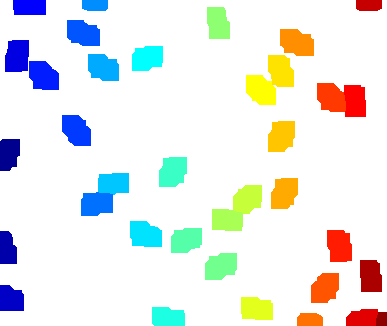我手头有一张图像(png格式),椭圆形的边界线(代表细胞核)是直线,不太实用。我该如何从图像中提取这些线并使其弯曲,前提是它们仍然围绕着细胞核。
以下是该图像:
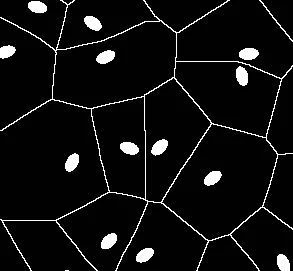 弯曲后:
弯曲后:
 编辑:如何将答案2中的“膨胀和过滤”部分翻译成Matlab语言?我想不出来。
编辑:如何将答案2中的“膨胀和过滤”部分翻译成Matlab语言?我想不出来。
以下是该图像:
 弯曲后:
弯曲后:
 编辑:如何将答案2中的“膨胀和过滤”部分翻译成Matlab语言?我想不出来。
编辑:如何将答案2中的“膨胀和过滤”部分翻译成Matlab语言?我想不出来。 弯曲后:
弯曲后:
 编辑:如何将答案2中的“膨胀和过滤”部分翻译成Matlab语言?我想不出来。
编辑:如何将答案2中的“膨胀和过滤”部分翻译成Matlab语言?我想不出来。i3是没有线条的输入图像):ColorCombine[{Image[
WatershedComponents[
DistanceTransform[Binarize@i3,
DistanceFunction -> ManhattanDistance] ]], i3, i3}]
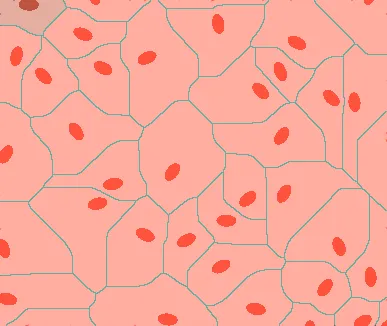
编辑
我正在使用另一种算法(初步结果)。您觉得如何?
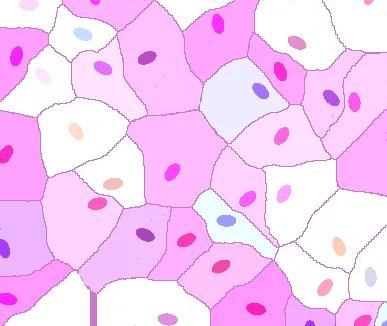
好的,这里有一种方法涉及到几个随机化步骤,能够获得“自然”非对称外观。
我发布了实际的Mathematica代码,以防万一有人需要将其翻译为Matlab。
(* A preparatory step: get your image and clean it*)
i = Import@"http://i.stack.imgur.com/YENhB.png";
i1 = Image@Replace[ImageData[i], {0., 0., 0.} -> {1, 1, 1}, {2}];
i2 = ImageSubtract[i1, i];
i3 = Inpaint[i, i2]
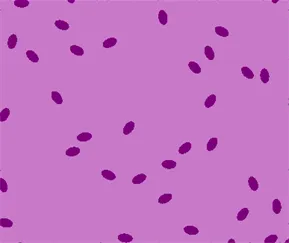
(*Now reduce to a skeleton to get a somewhat random starting point.
The actual algorithm for this dilation does not matter, as far as we
get a random area slightly larger than the original elipses *)
id = Dilation[SkeletonTransform[
Dilation[SkeletonTransform@ColorNegate@Binarize@i3, 3]], 1]
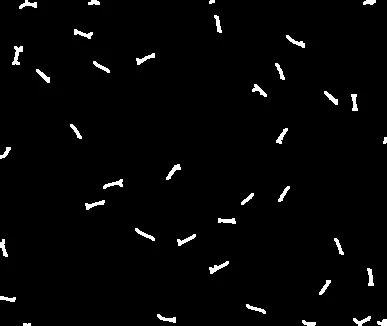
(*Now the real random dilation loop*)
(*Init vars*)
p = Array[1 &, 70]; j = 1;
(*Store in w an image with a different color for each cluster, so we
can find edges between them*)
w = (w1 =
WatershedComponents[
GradientFilter[Binarize[id, .1], 1]]) /. {4 -> 0} // Colorize;
(*and loop ...*)
For[i = 1, i < 70, i++,
(*Select edges in w and dilate them with a random 3x3 kernel*)
ed = Dilation[EdgeDetect[w, 1], RandomInteger[{0, 1}, {3, 3}]];
(*The following is the core*)
p[[j++]] = w =
ImageFilter[ (* We apply a filter to the edges*)
(Switch[
Length[#1], (*Count the colors in a 3x3 neighborhood of each pixel*)
0, {{{0, 0, 0}, 0}}, (*If no colors, return bkg*)
1, #1, (*If one color, return it*)
_, {{{0, 0, 0}, 0}}])[[1, 1]] (*If more than one color, return bkg*)&@
Cases[Tally[Flatten[#1, 1]],
Except[{{0.`, 0.`, 0.`}, _}]] & (*But Don't count bkg pixels*),
w, 1,
Masking -> ed, (*apply only to edges*)
Interleaving -> True (*apply to all color chanels at once*)]
]
结果是:
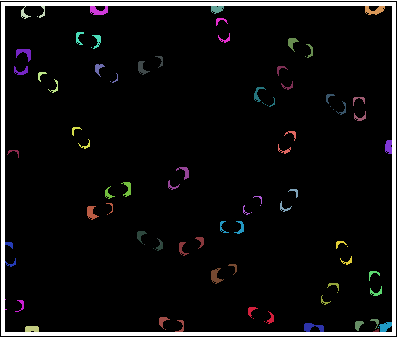
编辑
对于以Mathematica为导向的读者来说,最后一个循环的功能代码可能更容易(且更短):
NestList[
ImageFilter[
If[Length[#1] == 1, #1[[1, 1]], {0, 0, 0}] &@
Cases[Tally[Flatten[#1, 1]], Except[{0.` {1, 1, 1}, _}]] & , #, 1,
Masking -> Dilation[EdgeDetect[#, 1], RandomInteger[{0, 1}, {3, 3}]],
Interleaving -> True ] &,
WatershedComponents@GradientFilter[Binarize[id,.1],1]/.{4-> 0}//Colorize,
5]
这是我想到的翻译,它不是@belisarius代码的直接翻译,但应该足够接近。
%# read image (indexed image)
[I,map] = imread('http://i.stack.imgur.com/YENhB.png');
%# extract the blobs (binary image)
BW = (I==1);
%# skeletonization + dilation
BW = bwmorph(BW, 'skel', Inf);
BW = imdilate(BW, strel('square',2*1+1));
%# connected components
L = bwlabel(BW);
imshow(label2rgb(L))
%# filter 15x15 neighborhood
for i=1:13
L = nlfilter(L, [15 15], @myFilterFunc);
imshow( label2rgb(L) )
end
%# result
L(I==1) = 0; %# put blobs back
L(edge(L,'canny')) = 0; %# edges
imshow( label2rgb(L,@jet,[0 0 0]) )
function p = myFilterFunc(x)
if range(x(:)) == 0
p = x(1); %# if one color, return it
else
p = mode(x(x~=0)); %# else, return the most frequent color
end
end
结果:
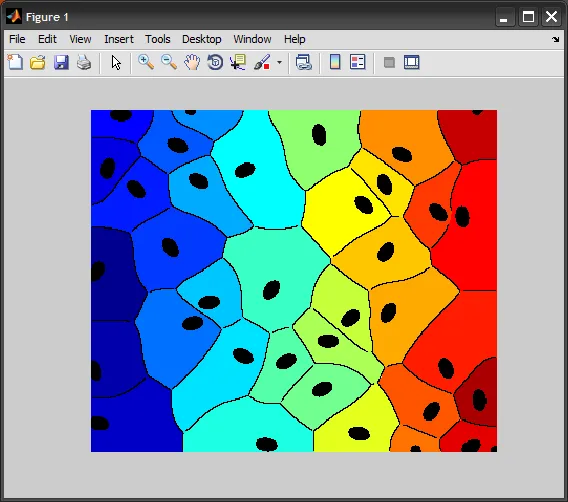
以下是该过程的动画:
